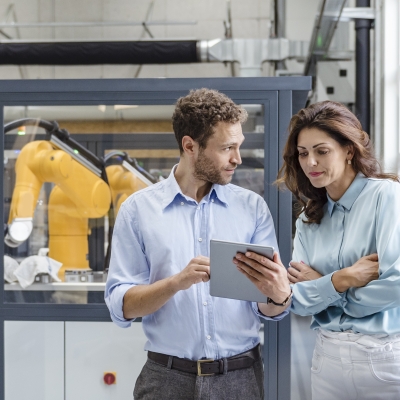Moving Smart Metering Data into the Cloud

Moving Smart Metering Data into the Cloud
Empowering utilities for a sustainable future
Leading solutions for end-to-end meter data management and cloud migration
Siemens Advanta's end-to-end, digital transformation services and solutions for utilities come with in-depth expertise in Meter Data Management implementation, customization, and seamless integration. These capabilities, paired with Azure certified cloud migration proficiency, made us the partner of choice for UK Power Networks' (UKPN) project to move its metering data into the cloud and to achieve operational excellence in digitalization - at scale.
See some of the capabilities we offer:
End-to-end solutions at scale: From conceptualization to implementation and ongoing support, we guide you through the entire journey of digital transformation.
Cloud migration expertise: Certified Azure partner ensuring a smooth transition of complex systems to the cloud.
Operational competence: Our teams provide continuous support and maintenance post-implementation, ensuring your systems operate at peak efficiency.
We are delighted with the seamless migration to Microsoft Azure. Moving to the cloud is also a key step towards enabling the country’s Net Zero transition. By building capacity to manage the increasing data from smart meters, we are ready for the growth of smart meters and low carbon technologies including electric vehicles and heat pumps.

Read full Press Release
Read the press release our client UKPN published on their successful MDM cloud migration project, with Siemens Advanta providing design, delivery and ongoing maintenance support services within this project.
Our industry leader

Strategy and Digital Transformation

Strategy & Digital Transformation
Siemens Advanta approaches digital transformation in a customer-centric way to accompany our clients on their digital journey to sustainable success.
Comprehensive digital transformation solutions for sustainable success
Digitalization has revolutionized how businesses operate, resulting in dynamic markets, evolving technologies, and shifting trends. As companies navigate increasing complexity and uncertainty, meeting changing customer expectations is crucial for success. At Siemens Advanta, we enable businesses to unlock their full potential by embracing digital transformation while always keeping the customer in focus. Leveraging our vast expertise, we deliver tangible results for our clients in record time, covering every aspect of their digital transformation journey. Together, we pave the way for win-win solutions and superior customer experiences.
Explore our tailored portfolio to support your business needs

Latest Strategy & Digital Transformation insights

Our industry leaders



The Rise in Cognitive Cities, Buildings and Infrastructure as the Next Generation of Urban Management

The Rise in Cognitive Cities, Buildings and Infrastructure as the Next Generation of Urban Management
Urbanization is on the rise. More than half of the world’s population now live in urban areas and this is expected to increase to circa 70% by 2050, according to the United Nations. Around the globe, and particularly in the Middle East, there are many plans underway to develop entirely new urban living areas, to accommodate the population rise and expatriate influx. Both Abu Dhabi and Dubai were recently ranked as the smartest cities in the MENA region. With many new infrastructure plans underway, this ranking is expected to climb even higher globally.
These trends set a pressing need to build and expand services, infrastructure, city management, and controls within these increasingly populated areas. With these numbers expected only to grow, strategic planning is of utmost importance to ensure long-term efficiency, safety, and quality of life. As the technological landscape continues to develop at a rapid pace, and digitization now touches nearly every industry, a key component of current and future planning will be the integration of smart and cognitive solutions.
Bringing Smart Cities to Life
Before continuing, it is useful to set some parameters around what we mean when we say ‘smart’. The word itself is central to so much innovation, and as a prefix, it has migrated away from being attributed to personal devices (such as a smart watch or smart phone), to increasingly becoming a feature of many target systems and services that will be provided by governments and private companies, forming the interface between users, customers and service providers with the end goal being to create more efficient and optimized services. A ‘smart’ system will be able to operate in its own silo, typically without the need for human intervention. It will be able to track, recognize and produce data or responses according to its purpose.
But where are we today? Across the globe, we have been edging towards a more integrated digitized experience for some time now. With new smart features being introduced that form the initial buildings blocks of fully integrated smart cities in the future. The Middle East has already long been a proponent of innovation and leveraging the best of disruptive technology. In particular, the UAE and Saudi Arabia are setting a new benchmark when it comes to smart technology for customers and residents. Smart systems are becoming more common across many government and private buildings and processes and have been for several years now. They provide responsive interfaces for users and consumers and relieve much of the manual efforts, as well as costs to services, and provide significant reductions on environmental impacts. Dubai has over 100 Smart initiatives and over 1,000 smart services - many as a result of collaboration and cooperation between government and private companies. This number is expected to grow significantly, in line with the number of exciting new infrastructure products as part of the agenda to become ‘the happiest city on earth’. This vision is underpinned by the objective of leveraging technological advancements to optimize resources, integrate services seamlessly, and protect people and their information.
Siemens Advanta recently worked with Dubai to complete an Internet of Things (IoT) strategy for the city to help identify, prioritize and define smart initiatives, which included an assessment of central computing platform options to create an integrated citywide command center. Implementation of these initiatives is expected to lead to substantial benefits, including operational cost savings (up to 30%), improvement in overall resident and customer satisfaction (up to 20%), reduction in emergency response times (up to 80%), and reduction in non-revenue water use (up to 35%).
This is an excellent case study for demonstrating that buildings and environments that adapt to human needs, create safer and more harmonized living and contribute to a more sustainable future. Overall, folding smarter and sensory technologies into urban planning, and architectural and interior design will not only increase competitiveness but ensure that present and future generations’ economic, social, and environmental needs are also met.
The Future of Cognitive Cities
Smart security systems, smart access, and smart metering (to name a few) are now becoming part of common jargon. More recently, and in line with the accelerated growth of technology, the term ‘cognitive’ has also entered the lexicon.
What’s the difference between smart and cognitive systems? While a smart system is used to measure, track, communicate, and collaborate with its users, a cognitive system independently intuits and anticipates.
To put it another, simpler way: imagine a meeting that is held in a conference room at the same time every week. The heating system for this room is accessible and controllable from an individual mobile device. Given the number of attendees within the meeting room the temperature of the room can increase, so the users are able to adjust, using their devices. That is a smart system. But now imagine that that same system would recognize both the pattern of the meeting cadence and the increase in temperature and then adjust itself at the same time the following week to accommodate the extra body heat. That is a cognitive system.
Both systems are fundamentally intelligent but as this example shows, while a smart system is able to be digitally controlled, a cognitive system goes one step further and is able to adjust and self-regulate according to user and customer needs. Through prediction and enablement, cognitive systems offer the most sophisticated, human-centric solutions that exist today.
The concept of cognitive is still considered emerging, but it is a trend that we can expect to see growing in the very near future and ultimately, replacing its ‘smart’ predecessor. With the use of self-learning artificial intelligence (AI), a cognitive infrastructure will be able to provide fully integrated solutions that move away from siloed systems, and communicate and learn across a network of enabled services. It is the ultimate vision for a fluid end-to-end process that benefits both the user/customer base and the provider through seamless experiences, while enabling long-term cost savings and significant reductions in environmental impacts for the provider. Simultaneously, its sophistication will only continue to grow with machine learning technology at its core.
But getting it right is key: from the very first point of data, a cognitive system needs to be able to accurately register and understand the user requirements. We have seen minor challenges with this in the recent past, with many of the machine learning technologies that make up cognitive solutions. Given that many of them are still at a comparatively nascent stage, the rate of pace at which they are developing and improving is extremely fast.
Smart and cognitive infrastructure is not just about increasing the end user’s human comfort level and ease of effort. From an economical point of view, they can deliver long-term cost savings by reducing the wastage of services and energy. There is a wider imperative and obligation to ensure that we are investing in longer-term sustainable solutions that will help reverse the negative impact on the environment. As the topic of ESG (Environmental, Social and Governance) rises on the agenda for both government and private companies alike, both are looking to technologies to enable their core objectives. The valuable data collected by these systems can enable city and building management to make informed and strategic adjustments. This covers all three layers of a city and building’s infrastructure:
- The sub-layer: includes water, gas and electricity delivery and waste disposal
- The surface level: engages directly with users, residents and customers, such as transportation, retail, in-person services and recreational activities
- The vertical layer: includes energy consumption
Applying a digital layer across all three of these provides a more detailed insight into gaps and required adjustments than has ever been accessible before.
Paving the Way for Cognitive Transformation
Cognitive systems will provide a competitive advantage across multiple industries, including healthcare, manufacturing, mobility, and buildings. Through customer and user-centric data gathering, these systems can continuously update and amend their operating structures based on customer and user preferences and interactions. Businesses will benefit from ongoing optimizations to their human services, environmental impact, safety & security, utilities, and operational intelligence. Stay ahead of the curve with the limitless potential of cognitive systems.
There is no doubt that technology adds to the desirability and attractiveness of residential properties, communities and services, as well as tourist experiences. From a user and customer perspective, smart and cognitive systems can improve quality, ease of use and safety and security, among many other benefits. Meanwhile, cost reduction, ESG considerations, improved data management, and enhanced governance all stand as pivotal advantages for service providers, thereby futureproofing their business and ensuring continued growth through investments in smart technology.
In the imminent future, the most prosperous communities will have technology at their core, equipped to facilitate growth and development. All businesses, both public and private, should start to consider how their ways of operating will tie in with a larger, more cognitive-based infrastructure that will underpin future ways of living.
Free whitepaper
Each city has its unique requirements to tackle during the transformation that starts with city theory and then becomes smart tech reality! We guide you through the process, with a uniquely comprehensive roadmap designed to successfully implement your smart city, putting technology at the core of it all.
Our contributors


Author


Large Scale Digital Transformation & End-to-End services

Large Scale Digital Transformation & End-to-End Services
Siemens Advanta supports the digital transformation of buildings, campuses and districts with an agile partnership approach. Together with our clients, we explore innovation opportunities to create a roadmap for digital transformation. We then design and implement our clients' flexible, future-proof and scalable digital solution to achieve the best economic and technical outcome.
- Unlock real estate value through data
- Reach sustainability targets
- Gain holistic view of buildings, campuses or districts to exploit synergies
Our industry leaders


Driving digital transformation and open innovation with a strong ecosystem
Tune in to uncover what the world of open innovation ecosystem holds for the future.
How can cross-collaboration and open ideation help deal with industrial uncertainties? Get your answers from Aymeric Sarrazin and Peter Körte.
Find us also on your favorite Podcast APP:
Apple Podcast, Google Podcast, Siemens.fm,
Stitcher, Spotify (log in to listen on desktop)
Facilitating Achievement of ESG & Net Zero Goals for Buildings & Campuses

Facilitating Achievement of ESG & Net Zero Goals for Buildings & Campuses
Digital Transformation of your Properties
Keeping your building portfolio compliant with new regulations and reaching ESG (Environmental, Social and Governance) goals in today’s ever-changing environment is not an easy task. It will not be sufficient to optimize the individual processes and management systems within a building. Digitalization, integration, and coordinated, centralized management will be key as holistic, sustainable decisions can only be made with full transparency.
From sustainability strategy to implementation, we support the digital transformation of your properties. Take the transformative path with us – from setting a goal to potential analysis to blueprint and piloting up to implementation and rollout.
Together, we will find the right way to begin your ESG project – regardless of your current status.
We support in reducing the risk of “stranded assets”
Tackle the challenge of early economic obsolescence of buildings that get devaluated and are non-performing.
We help define your decarbonization pathway to comply with regulatory energy efficiency standards. By focusing on your sustainability goals, also tenant expectations can be met leading to reduced vacancies and higher rents.
Being able to measure, report and improve data relating to energy, water and waste is a core success factor in this respect.
Find out how we can support the Digital Transformation of your Building Portfolio
Our Offering to Support Your Digitial Transformation Journey towards achieving ESG And Net Zero Goals
- Definition of ESG and Net Zero strategy for the building portfolio
- Prioritization of ESG and Net Zero topics and relevant criteria/KPIs and use cases to increase ESG rating
- Assess potential risks and develop an action plan for the portfolio
- Structured inventory of existing buildings, systems, data
- Target-actual comparison to identify required data
- Business case and feasibility study for digital solutions and to improve defined ESG and Net Zero KPIs
- System architecture blueprint and organizational transformation plan
- Listing/ evaluation of possible technical solutions and partners
- Project planning
- Turn-key implementation with technical solutions, products and support for organizational transformation
Guide your path to better ESG ratings and Net Zero
Reduce vacancies and achieve higher rents by exceeding tenant expectations towards sustainability
Support on a modular basis or with a comprehensive solution
Bridge sustainability, technology, and the real estate market
ESG Strategy & Governance

ESG Strategy and Governance
We help organizations develop comprehensive ESG strategies and governance frameworks tailored to their unique needs. Our approach helps businesses to identify key ESG topics, establish ambitious goals, and create a clear roadmap for implementation. With our expertise organizations can capitalize on ESG opportunities while satisfying the demands of diverse stakeholder groups.
- Gain transparency on organizations’ ESG activities and regulatory requirements, e.g., by identifying and streamlining competing initiatives across the company
- Develop a clear sustainability vision and roadmap that aligns with business objectives and values, e.g., by conducting materiality assessments
- Establish and prioritize measurable targets and KPIs to effectively track ESG performance and success, e.g., a carbon neutrality timeline or a goal for circularity
- Install a dedicated and integrated governance system with clearly defined roles and responsibilities, e.g., dedicated sustainability responsible per organizational unit
- Implement a robust reporting infrastructure to enhance transparency and accountability on ESG matters, e.g., automated reporting dashboards with core KPIs
Our industry leader

IoT Living Lab for University Campus

IoT Living Lab for University Campus
Design and implement IoT living lab
Siemens Advanta creates IoT living labs for universities, which are enabled by the exploration of the most valuable digital use cases. This approach is supported by a digital transformation office which helps universities to scale their new digital business models. Campuses are turned into IoT test beds to drive innovation and research on emerging topics like decarbonization and digitalization.
- Consulting and integration
- Accelerate digital transformation of university campus
- Gain comprehensive insights for research and academics
- Improve sustainability and drive decarbonization
Our industry leader








 Contact Us
Contact Us







